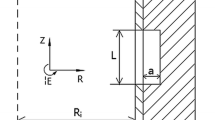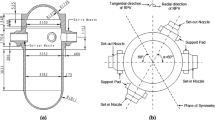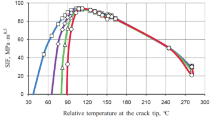Abstract
The integrity of reactor pressure vessel (RPV) is greatly affected by pressurized thermal shock (PTS). Once crack appears in the nozzle region, the stress concentration around the crack tips may lead to crack propagation, and finally cause a serious security problem. When the transient temperature is above the nil-ductility reference temperature, elastic–plastic constitutive relations are considered in the fracture mechanics analysis. The temperature-related properties of the materials are introduced into a 3-D finite element model to establish the temperature field and stress field of a real RPV. Since the test and safety inspection for RPV with defects under PTS loads are quite difficult and dangerous, the process of the ductile crack propagation is simulated by the extended finite element method (XFEM), and the critical crack sizes for different base wall thicknesses are determined. Then, the quantitative analysis of the effect of the crack position on the ultimate bearing capacity is carried out. For the crack tips with different shapes, the crack propagation law and the shape effect on the ultimate bearing capacity of the whole structure are also analyzed. According to their crack propagation paths and damage degrees, a good agreement is obtained.























Similar content being viewed by others
References
Abaqus Users Manual, Version 6.13-2 (2013) Dassault Systemes Simulia Corporation. Providence, Rhode Island, USA
ASME (2010) Boiler and pressure vessel code, section XI. Rules for Inservice inspection of nuclear power plant components. American Society of Mechanical Engineers, New York
ASTM E1820 (2016) Standard test method for measurement of fracture toughness. American Society for Testing of Materials, West Conshohocken, USA
Barani OR, Khoei AR, Mofid M (2011) Modeling of cohesive crack growth in partially saturated porous media; a study on the permeability of cohesive fracture. Int J Fract 167(1):15–31
Bass BR, Pugh CE, Sievers J, Schulz H (2001) Overview of the international comparative assessment study of pressurized thermal-shock in reactor pressure vessels (RPV PTS ICAS). Int J Press Vessels Pip 78:197–211
Beardsmore DW, Dowling AR, Lidbury DPG, Sherry AH (2003) The assessment of reactor pressure vessel defects allowing for crack tip constraint and its effect on the calculation of the onset of the upper shelf. Int J Press Vessels Pip 80(11):787–795
Belytschko T, Gracie R (2007) On XFEM applications to dislocations and interfaces. Int J Plast 23:1721–1738
Benzeggagh ML, Kenane M (1996) Measurement of mixed-mode delamination fracture toughness of unidirectional glass/epoxy composites with mixed-mode bending apparatus. Compos Sci Technol 56(4):439–449
Bland DR (1957) The associated flow rule of plasticity. J Mech Phys Solids 6(1):71–78
Chen M, Lu F, Wang R, Ren A (2014) Structural integrity assessment of the reactor pressure vessel under the pressurized thermal shock loading. Nucl Eng Des 272:84–91
Chou HW, Huang CC (2014) Effects of fracture toughness curves of ASME Section XI-Appendix G on a reactor pressure vessel under pressure–temperature limit operation. Nucl Eng Des 280:404–412
Dickson TL, Keeney JA, Bryson JW (2000) Validation of a linear-elastic fracture methodology for postulated flaws embedded in the wall of a nuclear reactor pressure vessel. In: Proceedings of ASME pressure vessel and pipings, PVP, vol 403, Seattle
Elguedj T, Gravouil A, Combescure A (2006) Appropriate extended functions for X-FEM simulation of plastic fracture mechanics. Comput Methods Appl Mech Eng 195:501–515
EN ISO 6892-1 (2009) Metallic materials, tensile testing part 1: method of test at ambient temperature. European Committee for Standardization (CEN), Brussels
Fagerström M, Larsson R (2008) A thermo-mechanical cohesive zone formulation for ductile fracture. J Mech Phys Solids 56(10):3037–3058
González-Albuixech VF, Qian G, Sharabi M, Niffenegger M, Niceno B, Lafferty N (2015) Comparison of PTS analyses of RPVs based on 3D-CFD and RELAP5. Nucl Eng Des 291:168–178
Heming C, Xieqing H, Jianbin X (2003) Comparision of surface heat-transfer coefficients between various diameter cylinders rapid cooling. J Mater Process Technol 138:399–402
Hu J, Cocks ACF (2016) A multi-scale self-consistent model describing the lattice deformation in austenitic stainless steels. Int J Solids Struct 78–79:21–37
IAEA-TECDOC-1627 (2010) Pressurized thermal shock in nuclear power plants: good practices for assessments. International Atomic Energy Agency, Austria
Jhung MJ, Choi YH, Jang C (2009) Structural integrity of reactor pressure vessel for small break loss of coolant accident. J Nucl Sci Technol 46(3):310–315
Keim E, Schmidt C, Schöpper A, Hertlein R (2001) Life management of reactor pressure vessels under pressurized thermal shock loads: deterministic procedure and application to Western and Eastern type of reactors. Int J Press Vessels Pip 78:85–98
Kim JK, Shin CH, Seo BK, Kim MH, Lee GJ (2000) A fast neutron fluence reduction strategy for pressure vessel lifetime extension. J Nucl Sci Technol 37:120–124
Lu C, He Y, Gao Z, Yang J, Jin W, Xie Z (2017) Microstructural evolution and mechanical characterization for the A508–3 steel before and after phase transition. J Nucl Mater 495:103–110
Mao JF, Zhu JW, Bao SY, Luo LJ, Gao ZL (2016) Creep deformation and damage behavior of reactor pressure vessel under core meltdown scenario. Int J Press Vessels Pip 139–140:107–116
Mao JF, Hu L, Bao S, Luo L, Gao Z (2017) Investigation on the RPV structural behaviors caused by various cooling water levels under severe accident. Eng Fail Anal 79:274–284
Marini B, Averty X, Wident P, Forget P, Barcelo F (2015) Effect of the bainitic and martensitic microstructures on the hardening and embrittlement under neutron irradiation of a reactor pressure vessel steel. J Nucl Mater 465:20–27
Moinereau D, Bezdikian G, Faidy C (2001) Methodology for the pressurized thermal shock evaluation: recent improvements in French RPV PTS assessment. Int J Press Vessels Pip 78:69–83
NRC (1996) Title 10, Section 50.61, fracture toughness requirements for protection against pressurized thermal shock events. U.S. Nuclear Regulatory Commission, Washington
Qian G, Niffenegger M (2013) Procedures, methods and computer codes for the probabilistic assessment of reactor pressure vessels subjected to pressurized thermal shocks. Nucl Eng Des 258:35–50
Qian G, Gonzalez-Albuixech VF, Niffenegger M (2014) In-plane and out-of-plane constraint effects under pressurized thermal shocks. Int J Solids Struct 51(6):1311–1321
Roychowdhury S, Seifert HP, Spätig P, Que Z (2016) Effect of high-temperature water and hydrogen on the fracture behavior of a low-alloy reactor pressure vessel steel. J Nucl Mater 478:343–364
Siegele D, Hodulak L, Varfolomeyev I, Nagel G (1999) Failure assessment of RPV nozzle under loss of coolant accident. Nucl Eng Des 193:265–272
Singh IV, Mishra BK, Bhattacharya S, Patil RU (2012) The numerical simulation of fatigue crack growth using extended finite element method. Int J Fatigue 36(1):109–119
Su X, Yang Z, Liu G (2010) Finite element modelling of complex 3D static and dynamic crack propagation by embedding cohesive elements in Abaqus. Acta Mech Solida Sin 23:271–282
Sun X, Chai G, Bao Y (2017) Ultimate bearing capacity analysis of a reactor pressure vessel subjected to pressurized thermal shock with XFEM. Eng Fail Anal 80:102–111
Tanguy B, Besson J, Piques R, Pineau A (2005) Ductile to brittle transition of an A508 steel characterized by Charpy impact test: Part I: experimental results. Eng Fract Mech 72(1):49–72
Woods R, Siu N, Kolaczkowski A, Galyean W (2001) Selection of pressurized thermal shock (PTS) transients to include in PTS risk analyses. Int J Press Vessels Pip 78:179–183
Wu S, Jin H, Sun Y, Cao L (2014) Critical cleavage fracture stress characterization of A508 nuclear pressure vessel steels. Int J Press Vessels Pip 123–124:92–98
Yuan H, Li X (2014) Effects of the cohesive law on ductile crack propagation simulation by using cohesive zone models. Eng Fract Mech 126:1–11
Yuan H, Lin G, Cornec A (1995) Quantifications of crack constraint effects in an austenitic steel. Int J Fract 71(3):273–291
Acknowledgements
Support for this study was funded by the National Natural Science Foundation of China (Grant Nos. 51105339 and 51275471), the Zhejiang Provincial Natural Science Foundation of China (Grant No. LQY18E050001). The authors declare that they have no conflict of interest. Furthermore, the authors are grateful for the technical support provided by the Key Laboratory of Special Purpose Equipment and Advanced Processing Technology of Ministry of Education.
Author information
Authors and Affiliations
Corresponding authors
Additional information
Publisher's Note
Springer Nature remains neutral with regard to jurisdictional claims in published maps and institutional affiliations.
Rights and permissions
About this article
Cite this article
Sun, X., Yao, J., Chai, G. et al. Numerical analysis of the influence factors of plastic failure in the cracked nozzle region of reactor pressure vessel. Int J Fract 214, 167–184 (2018). https://doi.org/10.1007/s10704-018-0326-3
Received:
Accepted:
Published:
Issue Date:
DOI: https://doi.org/10.1007/s10704-018-0326-3




